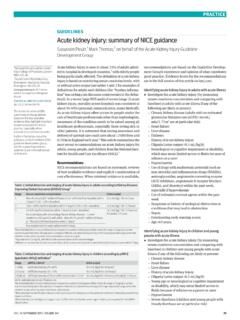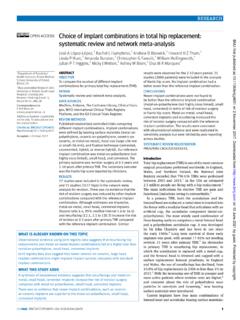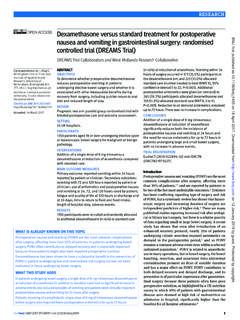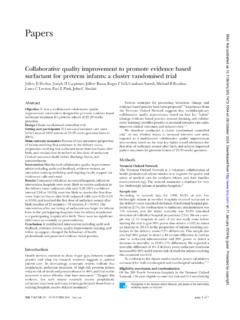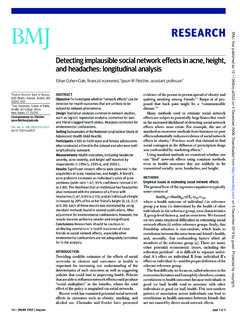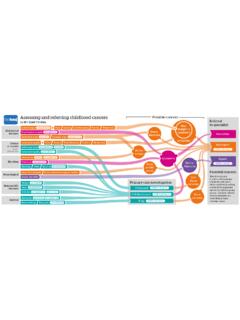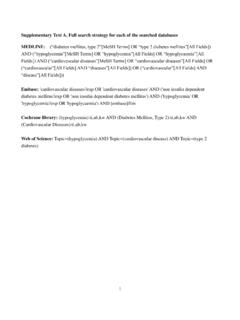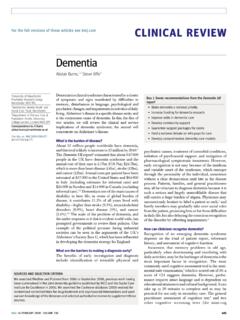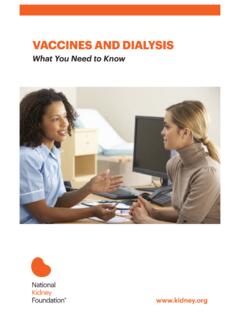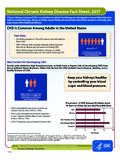Transcription of Sodium-glucose cotransporter protein-2 (SGLT-2) inhibitors ...
1 The bmj | BMJ 2021;372:m4573 | doi: 1 RESEARCHS odium-glucose cotransporter protein-2 (SGLT-2) inhibitors and glucagon-like peptide-1 (GLP-1) receptor agonists for type 2 diabetes: systematic review and network meta-analysis of randomised controlled trialsSuetonia C Palmer,1 Britta Tendal,2 Reem A Mustafa,3,4 Per Olav Vandvik,5 Sheyu Li,6,7 Qiukui Hao,8 David Tunnicliffe,9 Marinella Ruospo,10 Patrizia Natale,9,10 Valeria Saglimbene,10 Antonio Nicolucci,11 David W Johnson,12 Marcello Tonelli,13 Maria Chiara Rossi,11 Sunil V Badve,14 Yeoungjee Cho,12 Annie-Claire Nadeau-Fredette,15 Michael Burke,16 Labib I Faruque,17 Anita Lloyd,17 Nasreen Ahmad,17 Yuanchen Liu,17 Sophanny Tiv,17 Tanya Millard,2 Lucia Gagliardi,18,19 Nithin Kolanu,20 Rahul D Barmanray,21 Rita McMorrow,22 Ana Karina Raygoza Cortez,23 Heath White,2 Xiangyang Chen,6 Xu Zhou,24 Jiali Liu,25 Andrea Flores Rodr guez,23 Alejandro D az Gonz lez-Colmenero,23 Yang Wang,26 Ling Li,25 Surya Sutanto.
2 27 Ricardo Cesar Solis,23 Fernando D az Gonz lez-Colmenero,23 Ren Rodriguez-Gutierrez,23 Michael Walsh,28,29 Gordon Guyatt,4 Giovanni F M Strippoli9,10 ABSTRACTOBJECTIVETo evaluate Sodium-glucose cotransporter -2 (SGLT-2) inhibitors and glucagon-like peptide-1 (GLP-1) receptor agonists in patients with type 2 diabetes at varying cardiovascular and renal SOURCESM edline, Embase, and Cochrane CENTRAL up to 11 August CRITERIA FOR SELECTING STUDIESR andomised controlled trials comparing SGLT-2 inhibitors or GLP-1 receptor agonists with placebo, standard care, or other glucose lowering treatment in adults with type 2 diabetes with follow up of 24 weeks or longer. Studies were screened independently by two reviewers for eligibility, extracted data, and assessed risk of OUTCOME MEASURESF requentist random effects network meta-analysis was carried out and GRADE (grading of recommendations assessment, development, and evaluation) used to assess evidence certainty.
3 Results included estimated absolute effects of treatment per 1000 patients treated for five years for patients at very low risk (no cardiovascular risk factors), low risk (three or more cardiovascular risk factors), moderate risk (cardiovascular disease), high risk (chronic kidney disease), and very high risk (cardiovascular disease and kidney disease). A guideline panel provided oversight of the systematic trials including 421 346 patients proved eligible. All results refer to the addition of SGLT-2 inhibitors and GLP-1 receptor agonists to existing diabetes treatment. Both classes of drugs lowered all cause mortality, cardiovascular mortality, non-fatal myocardial infarction, and kidney failure (high certainty evidence). Notable differences were found between the two agents: SGLT-2 inhibitors reduced admission to hospital for heart failure more than GLP-1 receptor agonists, and GLP-1 receptor agonists reduced non-fatal stroke more than SGLT-2 inhibitors (which appeared to have no effect).
4 SGLT-2 inhibitors caused genital infection (high certainty), whereas GLP-1 receptor agonists might cause severe gastrointestinal events (low certainty). Low certainty evidence suggested that SGLT-2 inhibitors and GLP-1 receptor agonists might lower body weight. Little or no evidence was found for the effect of SGLT-2 inhibitors or GLP-1 receptor agonists on limb amputation, blindness, eye disease, neuropathic pain, or health related quality of life. The absolute benefits of these drugs vary substantially across patients from low to very high risk of cardiovascular and renal outcomes For numbered affiliations see end of the to: G F M Strippoli (or @gstrip3 on Twitter: ORCID 0000-0002-6936-0616)Additional material is published online only. To view please visit the journal this as: BMJ 2021;372:m4573.
5 16 October 2020 WHAT IS ALREADY KNOWN ON THIS TOPICA lthough trial results conflict, Sodium-glucose transporter 2 (SGLT-2) inhibitors and glucagon-like peptide-1 (GLP-1) receptor agonists probably reduce cardiovascular and kidney disease when added to other glucose lowering treatment in adults with type 2 diabetesUncertainty remains about the relative and absolute benefits and harms of these drugs across all important outcomes in patients with type 2 diabetes at varying levels of cardiovascular and kidney disease riskWHAT THIS STUDY ADDS Benefits shared by SGLT-2 inhibitors and GLP-1 receptor agonists include reductions in all cause and cardiovascular mortality, myocardial infarction, kidney failure, and serious hyperglycaemia (high certainty evidence) and lower body weight (low certainty) without incurring severe hypoglycaemia (high certainty)The two drug classes appear to have similar relative effects on all cause and cardiovascular mortality, myocardial infarction, kidney failure, health related quality of life, and serious hyperglycaemiaAbsolute benefits of these drugs vary substantially based on cardiovascular and renal disease risk profiles of patients with type 2 diabetes, as reflected in risk stratified BMJ Rapid Recommendations directly informed by this systematic review on 13 February 2022 by guest.
6 Protected by : first published as on 13 January 2021. Downloaded from RESEARCH2 doi: | BMJ 2021;372:m4573 | the bmj(eg, SGLT-2 inhibitors resulted in 3 to 40 fewer deaths in 1000 patients over five years; see interactive decision support tool ( #!/) for all patients with type 2 diabetes, SGLT-2 inhibitors and GLP-1 receptor agonists reduced cardiovascular and renal outcomes, with some differences in benefits and harms. Absolute benefits are determined by individual risk profiles of patients, with clear implications for clinical practice, as reflected in the BMJ Rapid Recommendations directly informed by this systematic REVIEW REGISTRATIONPROSPERO affects half a billion people worldwide and accounted for million deaths in Glucose lowering is a mainstay of In people with type 2 diabetes and higher risks of cardiovascular disease, several large scale randomised controlled trials have investigated Sodium-glucose cotransporter -2 (SGLT-2) inhibitors and glucagon-like peptide-1 (GLP-1))
7 Receptor agonists and reported reductions in cardiovascular mortality and non-fatal cardiovascular complications with both classes of 4 The mortality reductions have not, however, proved consistent across trials, leaving clinicians and patients uncertain of the magnitude of released in 2019 by the American Diabetes Association include using SGLT-2 inhibitors and GLP-1 receptor agonists in the management of diabetes for people with cardiovascular disease or kidney disease who have not reached their glycaemic target European Society of Cardiology guidelines in 2019 recommended SGLT-2 inhibitors and GLP-1 receptor agonists in people with type 2 diabetes and cardiovascular disease or a high risk of cardiovascular national Institute for Health and Care Excellence (NICE)
8 Guidance, updated in 2019, suggested a stepped approach to intensification of treatment with diabetes drugs, considering metformin as the first treatment with additions of dual and triple treatment from several drug classes, including SGLT-2 published systematic reviews and meta-analyses have summarised glucose lowering treatments for people with type 2 diabetes, including a network meta-analysis of stepped intensification of treatment added to metformin and Results from more recent meta-analyses report reductions in mortality and selected cardiovascular and renal events with both SGLT-2 inhibitors and GLP-1 receptor A network meta-analysis including all available glucose lowering treatments, the full range of important outcomes, GRADE (grading of recommendations assessment, development, and evaluation) certainty ratings, and estimates of absolute benefits and harms in patients with varying risks of cardiovascular and kidney disease remains unavailable.
9 Moreover, several large scale trials published recently require updated evidence 7 8 16We therefore conducted a systematic review and network meta-analysis evaluating the benefits and harms of SGLT-2 inhibitors and GLP-1 receptor agonists in adults with type 2 diabetes. This review is conducted as part of the BMJ Rapid Recommendations project, a collaborative initiative from the MAGIC (Making GRADE the Irresistible Choice) Evidence Ecosystem Foundation ( ) and The BMJ. The aim of the initiative is to provide trustworthy practice guidelines within months of newly released evidence, underpinned by rigorous evidence summaries. This systematic review is part of a forthcoming BMJ Rapid Recommendations cluster and a fuller version on MAGICapp ( ).
10 Although the network meta-analysis includes all classes of diabetes drugs, it focuses on these SGLT-2 inhibitors and GLP-1 receptor agonists added to other diabetes drugs, and in relation to one registrationWe registered the protocol for this systematic review with PROSPERO (CRD42019153180).Guideline panel involvementIn accordance with the BMJ Rapid Recommendations process, a guideline panel that comprised content experts, diabetologists, nephrologists, internal medicine physicians, primary care physicians, methodologists, and patients provided critical oversight of the review. The panel reviewed the protocol, identified the population, selected and ranked important patient outcomes, and recommended baseline risks on which absolute treatment effects were strategyThe literature search designed by an information specialist was conducted in Medline, Embase, and the Cochrane Central Register of Controlled Trials from March 2016 to 11 August 2020 without language restriction (appendix 1).
